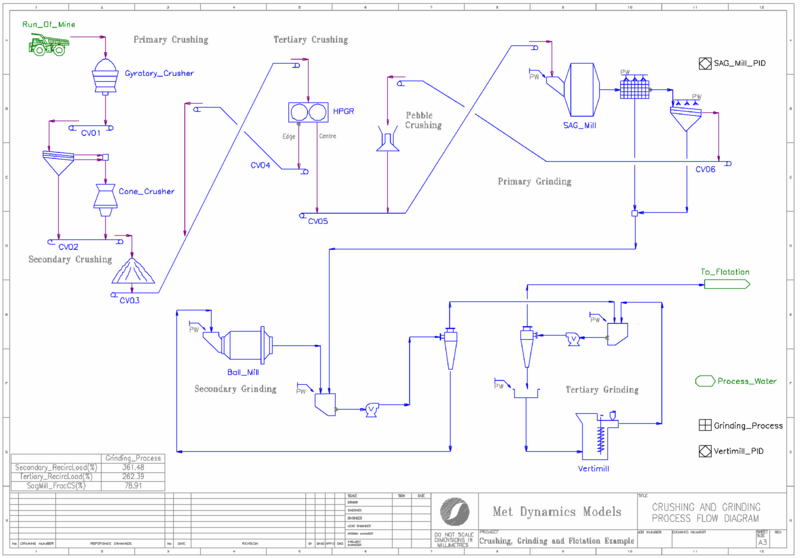Example - 09 Met Dynamics Projects
Navigation: User Guide ➔ Example Projects ➔ 09 MetDynamics
Crushing, Grinding and Flotation Example
Project Location
..\SysCADXXX\Examples\09 MetDynamics\Crushing, Grinding and Flotation Example.spf
Available from Build 139.35544.
Features Demonstrated
- The use of Met Dynamics - Crusher
- The use of Met Dynamics - HPGR
- The use of Met Dynamics - Mill
- The use of Met Dynamics - Screen
- The use of Met Dynamics - Hydrocyclone
- The use of Met Dynamics - Flotation
- The use of Met Dynamics - Pump
Brief Project Description
The project shows a multi-stage crushing and grinding circuit which consists of:
- Primary crushing
- Secondary crushing and screening
- Tertiary crushing using High Pressure Grinding Rolls (HPGR) with edge recycle
- Primary grinding with a Semi-Autogenous (SAG) mill, trommel and screen in closed circuit with a pebble crusher
- Secondary grinding with a ball mill and hydrocyclones in closed circuit
- Tertiary grinding with a stirred mill and hydrocyclones in closed circuit
This is followed by a multi-stage flotation circuit which consists of:
- Rougher flotation with five mechanical flotation cells
- Scavenger flotation with three mechanical flotation cells
- Cleaner flotation with four mechanical flotation cells
- Concentrate and tailings thickeners
The important mineral solids are represented by distinct chemical species (Au, CuFeS2, FeS2 and CaCO3) with the rest assigned to a Non-Sulphide Gangue pseudo species (NSG).
A PID controller is used to limit the SAG mill speed to either the installed motor power or the point where the mill media first impact the shell liner rather than the charge toe. A second PID controller adjusts the stirred mill speed to maintain a power draw set point.
Mineral solids in the grinding circuit product are distributed amongst size fractions using the Bazin polynominal method (Bazin et al, 1994). The minerals solids are then distributed to flotability components-by-size (Fast/Slow/Non-Floating) prior to being fed to the flotation circuit. These actions are performed by a General Controller.
A final PID controller adjusts the air flow rate in the final rougher cell to achieve a circuit mass pull set point.
Project Configuration
- The Met Dynamics - Crusher models in the primary, secondary and pebble crushing areas all use the Whiten method.
- The Met Dynamics - HPGR model in the tertiary crushing area uses the Torres HPGR method.
- The Met Dynamics - Mill model in the primary grinding area uses the AG/SAG (Variable Rates) method. The Media Trajectory calculation option is used to determine the point of media impact.
- The Met Dynamics - Screen models use the Vibrating (Metso) method (secondary screen, SAG screen) or the Vibrating (Whiten) method (SAG trommel).
- The Met Dynamics - Mill model in the secondary grinding area uses the Ball (Perfect Mixing) method. The Overfilling Indicator calculation option is used to identify if the mill is being overfilled at the simulated feed rate.
- The Met Dynamics - Mill model in the tertiary grinding area uses the Stirred (Perfect Mixing) method. The Nitta vertimill power calculation option is used to estimate the mill power draw.
- The Met Dynamics - Hydrocyclone models in the secondary and tertiary grinding areas both use the Narasimha-Mainza (2014) method.
- The Met Dynamics - Pump models in the secondary and tertiary grinding areas both use the Speed calculation mode.
- All Met Dynamics - Flotation models use the Savassi method.
References
- Bazin, C., Grant, R., Cooper, M. and Tessier, R., 1994. A method to predict metallurgical performances as a function of fineness of grind. Minerals Engineering, 7(10), pp.1243-1251.

